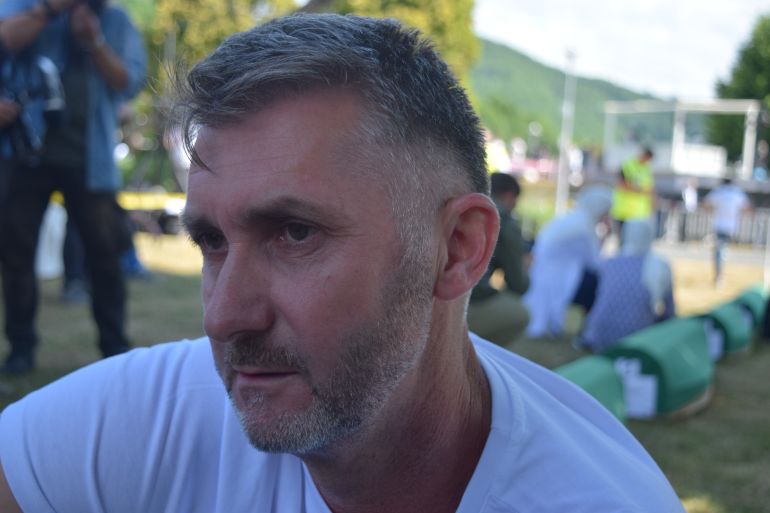Potocari, Bosnia and Herzegovina – In a grassy valley dotted with white gravestones, thousands of people gathered to mark 30 years since the Srebrenica massacre on Friday.
Seven victims of the 1995 genocide, some of whose remains were only discovered and exhumed in the past year from mass graves uncovered in Liplje, Baljkovica, Suljici and Kamenicko Brdo, were buried during the sombre anniversary on Friday.
Limited remains of one of the victims, Hasib Omerovic, who was 34 when he was killed, were found and exhumed from a mass grave in 1998, but his family delayed his burial until now, hoping to recover more.
Zejad Avdic, 46, is the brother of another of the victims being buried. Senajid Avdic was just 19 when he was killed on July 11, 1995. His remains were discovered in October 2010 at a site in Suljici, one of the villages attacked that day by Bosnian Serb forces.
“When the news came, at first, I couldn’t – I didn’t – dare tell my mother, my father. It was too hard,” Avdic told Al Jazeera, referring to the moment he learned that some of his brother’s remains had been found.
“What was found wasn’t complete, just a few bones from the skull.”
Families like Avdic’s have waited decades for even a fragment of bone to confirm their loved one’s death. Many have buried their loved ones with only partial remains.
The Srebrenica massacre was the crescendo of Bosnia’s three-year war from 1992 to 1995, which flared up in the aftermath of Yugoslava’s dissolution, pitting Bosnian Serbs against the country’s two other main ethnic populations – Croats and Muslim Bosniaks.
On July 11, 1995, Bosnian Serb forces stormed the enclave of Srebrenica, a designated United Nations-protected safe zone, overrunning the Dutch UN battalion stationed there. They separated at least 8,000 Bosniak men and boys from their wives, mothers and sisters, slaughtering them en masse.
Thousands of men and boys attempted to escape through the surrounding woods, but Serb forces chased them through the mountainous terrain, killing and capturing as many as they could. Women and children were expelled from the city and neighbouring villages by bus.
Thousands of people attended the commemoration for victims of the massacre on Friday, which began with a congregational Islamic prayer – men, women and children prostrating in unison among the rows of gravestones.
After the prayer, the remains of the victims, who have been identified using extensive DNA analysis, were carried in green coffins draped with the Bosnian flag.
The coffins were lowered into newly prepared graves. At each site, groups of men stepped forward to take turns covering the caskets with soil, shovelling from nearby mounds in a solemn conclusion to the proceedings.
After the remains had been buried, the victims’ families crowded around the sites, wiping away their tears as an imam recited verses over the caskets.

‘I will keep coming as long as I’m alive’
Fikrera Tuhljakovic, 66, attends the memorial here each year, but this year her cousin was among the victims being buried.
She said she is determined to ensure he is remembered and that all of the victims are never forgotten.
“I will keep coming as long as I’m alive,” Tuhljakovic told Al Jazeera.
Forensic scientists and the International Commission on Missing Persons have, in the decades since the mass killings, worked to locate the remains of those killed.
More than 6,000 victims have been buried at the memorial site in Potocari, but more than 1,000 remain missing.
![A woman mourns the burial of her loved one [Urooba Jamal/Al Jazeera]](https://i0.wp.com/www.aljazeera.com/wp-content/uploads/2025/07/DSC_0952-1752247869.jpg?w=696&ssl=1)
In 2007, the International Court of Justice (ICJ) declared the events in Srebrenica and the surrounding area a genocide. Bosnian Serb leaders Radovan Karadzic and Ratko Mladic were both convicted of genocide, war crimes and crimes against humanity and sentenced to life in prison.
In total, the tribunal and courts in the Balkans have sentenced almost 50 Bosnian Serb wartime officials to more than 700 years in prison for the genocide.
But many accused remain unpunished. Denial of the genocide also continues – especially among political leaders in Serbia and the Serb-majority entity of Republika Srpska, which was established in the northeast of the country at the start of the war in 1992 with the stated aim of protecting the interests of the Serbs of Bosnia and Herzegovina.
According to Emir Cica, Islamic Relief’s Bosnia country director, international institutions have not done enough to prevent events like Srebrenica from happening again, with similar atrocities happening in Gaza at the moment.
“When we see what has happened, for example, in Gaza, it is very painful for us because we understand this [experience],” Cica told Al Jazeera.
For Avdic, Gaza is indeed a painful reminder of history repeating itself.
“Today we are burying our victims of genocide, and today in Gaza, genocide is happening, too,” he said solemnly.
“I don’t know what kind of message to send; there’s no effect on those in power who could actually do something.”

Source: Aljazeera

Leave a Reply